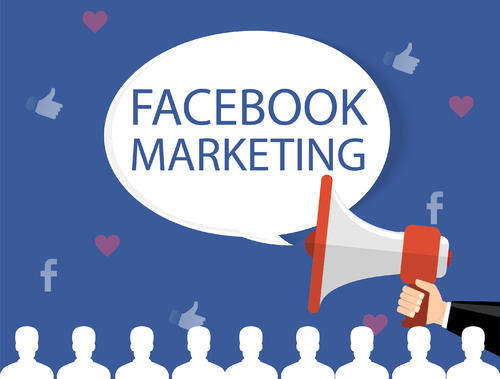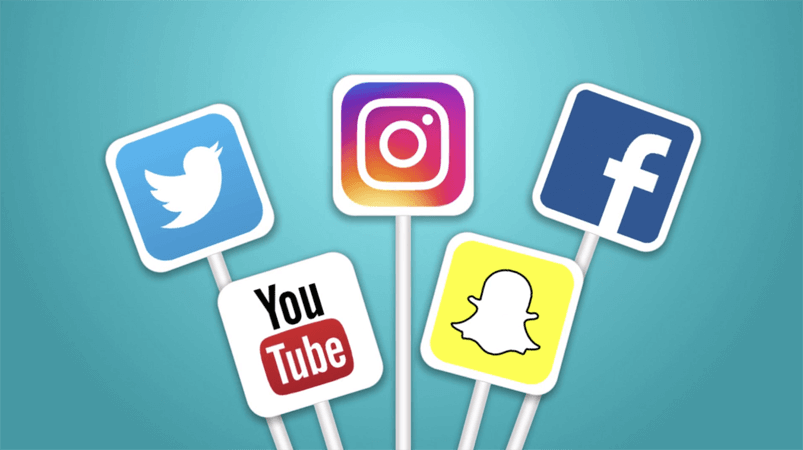Facebook Marketing in 2022: How to Use Facebook for Business
Facebook marketing is a MUST for businesses in 2022. Every day, you can reach 2.8 billion potential customers, who are already hanging out on the platform. Keep reading to learn everything you need to know to start marketing your business on Facebook—from setting up a Facebook Business Page to creating high-performing Facebook ads.
Whether you consider yourself a savvy social media marketer or not, there’s no doubt that the power of Facebook Ads can help your business grow. That’s why we created this set of easy-to-read guides to explain how to maximize your ad spend on the platform.
Setting up Facebook for your business takes just a few minutes. First, of course, you need to create a Page. Our step-by-step process will take you through the basics, and our Facebook Marketing guides have the expert insights to make the most out of your new business asset.
While setting up your business on Facebook is a powerful first step, protecting that business with the right insurance is just as essential. You’re investing time, money, and creative energy into building your brand—don’t let unforeseen risks unravel that effort. From data breaches and cyber threats to liability claims, the digital world brings its own share of vulnerabilities. That’s why business insurance isn’t just for brick-and-mortar setups anymore—it’s a must for online entrepreneurs, too.
To ensure you’re fully covered, the experts at simplyquote.co.uk can help you find a policy tailored to your unique business model. Whether you’re a solo marketer or running a full-fledged agency, they simplify the process of comparing coverage so you can focus more on your ad strategies and less on legal headaches. A little preparation now can save your business a lot later—and that’s a marketing move worth making.
If your business wants to get in on the Facebook page action, then you’re going to want to create one – or several – of your own. You read that right: Unlike with a Facebook profile, which can only ever be used by one single person, a Facebook Page can be run by a number of people. And because Pages are public-facing, any number of people can also access them for more information about your business. (Cool, huh?)
- Go to facebook.com/pages/create (Note: you’ll need to be signed in to your personal account to begin, but don’t worry: your personal information will not display on your new Business Page.)
- Select your page type: Community/public person or business/brand
- Enter your company’s information.
- Put your profile and cover photographs online. Use the finest picture sizes for Facebook to ensure that your images appear their best.
- Click Edit Page Info to include your description, contact information, and any other pertinent information like as operation hours.
- Create your vanity URL by clicking Create Page @Username. This may be up to 50 characters long and aids others in finding you on Facebook.
- Under your cover photo, click Add a Button to add a call to action such as “Shop” or “Contact Us.”
- Congratulate yourself: you’ve just released a Facebook Business Page into the world! And she’s stunning!
If you need a little more assistance with the setup, we’ve got you covered. Check out our whole guide on how to set up a Facebook Page for your business.
Once your Facebook Business Page is up and running, it’s time to dive into the real fun: Facebook marketing. This isn’t just about posting now and then—it’s about creating consistent, engaging content that resonates with your audience. Share behind-the-scenes peeks, post updates about new products or services, run promotions, and interact in the comments. And don’t forget about Facebook Ads. With targeting options sharper than your best suit, you can reach exactly who you want—by location, interests, age, and even behaviors.
Now, pair that with a solid chatbot on your website, and you’ve got a marketing dream team. While your Facebook Page keeps folks engaged on social media, a smart chatbot keeps the conversation going when they land on your site. Tools like https://strictly.ai make it easy to build a conversational website that’s always on, always helpful. Whether it’s answering FAQs, booking appointments, or capturing leads, the right chatbot ensures your visitors feel like someone’s always listening—even when you’re not glued to your desk.
Types of Facebook posts
Now that you have your own Facebook Business Page, it’s time to start creating content.
You may make many sorts of postings on Facebook. Each has its own set of benefits and may encourage participation in a variety of ways. We’ll go through all of the many options for Facebook Page posts, as well as some examples to help you get started.
Facebook photo post
Visual posts, on the whole, attract considerably higher interaction than text posts. An eye-catching photo (or drawing, or infographic, we don’t care!) is a great way to attract a potential buyer’s attention while they’re scrolling through their news feed.
Don’t worry if you’re not a skilled photographer — or if you’re selling something that’s tough to convey in a picture – stock photographs are here to help. (In fact, here are 25 free stock picture sites to visit!) Just make sure you grasp the fundamentals of picture copyright before you begin posting.)
Facebook video post
Engagement rates for video postings are much greater than for photo posts. Video can be immensely fascinating, whether it’s for a quick, cute video announcement or a longer, expertly crafted film with a narrative.
Posting a Facebook Live video
If pre-recorded videos aren’t your style, try trying with Live.
A Facebook Live video is a live-streamed broadcast that occurs on your Facebook Page. In spring 2020, Facebook Live watching increased by 50%, demonstrating that this medium is highly popular.
You may interact with your audience in a more personal and real way using live video.
Like Instagram Stories, Facebook Stories are vertically styled photo or video posts that disappear after 24 hours. Videos may be up to 20 seconds long, while photographs can be up to five seconds long.
Facebook Stories are unaffected by the Facebook algorithm because they display at the top of the News Feed. This might explain why over half a billion people watch Facebook Stories every day.
……Whew!
We recognise that there is a great deal to learn about Facebook marketing. The good news is that you don’t need to invest any money to get started.
So go ahead and get your hands dirty while studying. More complex plans and campaigns will be accessible when you’re ready… and our wealth of tools and tutorials will be there to help you every step of the way.
Adson can help you manage your Facebook presence as well as your other social media platforms. You can plan articles, share videos, engage with audience, and track the results of your efforts all from a single dashboard. Click here to know more.
- Published in Facebook, MEDIA BUYING, Social Media
The Art of Cross-Platform Campaign Planning: Tips and Examples
Learn how to run, plan, and track an effective social media campaign, and explore examples of successful campaigns.
You will be juggling metrics, audiences, and goals tailored to each social media platform if your brand has multiple social media accounts. It can be difficult to make sense of everything and to maintain an active, brand-consistent presence across platforms.
Are you looking for a way to turn a collection of scattered social media post ideas into a cohesive, powerful cross-platform campaign that takes advantage of the best aspects of every platform? Look no further!
In what way is a cross-platform campaign different from a conventional campaign?
Social media campaigns run across multiple platforms are known as cross-platform campaigns. Through customized messaging that meets your audience where they are, they generate awareness, interest, and conversions.
Your company can enjoy a seamless omnichannel marketing experience by creating original content that’s in line with the spirit of each platform, instead of “that ad feeling” people want to escape from. A campaign tailored to each platform’s posting specifications will also give your audience the best chance of engaging with you.
Cross-platform marketing campaigns: What are the benefits?
Cross-platform campaigns are not only a great way to avoid looking like a fool when Twitter ends your 400 word LinkedIn masterpiece at 280 characters, they also have numerous benefits:
· Different platforms are suitable for different purposes. You might build awareness on Instagram and Twitter, but convert through Facebook ads.
· Some platforms use visuals, while others use text. A cross-platform strategy ensures that your content is relevant no matter where it appears.
· They achieve greater reach than single-platform campaigns or copy-and-paste campaigns (reusing the same captions and images, even if they are not optimized for that platform’s specifications).
· Brand consistency builds loyalty and trust.
Cross-platform marketing tips: 9 tips for success
1. Develop a plan
We need to talk if your current advertising campaign strategy is “Promote new product launch.”.
Be sure to include S.M.A.R.T. goals, audience research, who’s doing what, and posting deadlines in all campaign plans. Start strong with our free cross-platform campaign template.
2. Establish platform-specific goals
Don’t just set goals for the campaign – set goals for every platform you’ll be using as well.
Certain platforms are designed for specific goals, so some of these goals will naturally flow.
· Instagram: Engaging and discovering visual content (Reels and Stories).
· Pinterest: Conversion-focused images of products.
· LinkedIn: Brand building and B2B marketing campaigns.
· Repeat for each of your campaign platforms.
Each platform will have different goals, of course. Pinterest can, for instance, be used for brand awareness as well as conversions. For each platform, however, set one or two goals.
3. Don’t copy and paste
It’s okay to repeat a key phrase throughout a campaign, but you shouldn’t use the same copy and visuals word-for-word across channels.
In that case, a “multi-platform campaign” loses its purpose, don’t you think?
From the number of characters you can use to the types of content that perform well, every social media platform is different. Tailor your content for the specific post specifications and demographics of each platform.
Plus, Insider information people like to share, like “link in bio” on Instagram or the latest dance trend on TikTok. Peter McKinnon’s short-but-sweet event announcement makes perfect sense on the platform he’s meant to use for it.
4. Make yourself available to chat
Posting and ghosting are not acceptable!
Two-way communication is essential in social media. You must be able to respond to your customers. In fact, 64% of them prefer messaging you to calling a 1-800 number.
Engage with customers by responding quickly to comments and direct messages.
What is the best part? Your team can be assigned responses or you can only see comments that need a response. This will allow your managers to work efficiently.
Provide an easy way for customers to ask questions pre- or post-purchase on your website in addition to responding on social media.
Your website and social channels, such as Facebook Messenger, can benefit from live chat apps. Using tools like Heyday, you can keep your costs down or provide your customer service representatives with the best service by utilizing AI-powered live chat.
Heyday allows you to assign messages to specific people or archive old threads if you plan on having your team handle chats. You can then ensure that everyone gets a prompt response to their questions.
5. Use both paid and organic methods
You wouldn’t rely only on organic traffic, just like you wouldn’t base your entire campaign solely on one social network, would you?
There is no need to hit the “promote” button on every post to make it appear as an ad. You don’t need a budget behind every post to reach a larger audience. You can boost a few more posts than usual if you’re not getting much engagement with your organic posts.
In addition, if an organic post is doing well, why not give it an extra push by promoting it?
You should think about what to promote versus what not to.
In acquisition ads, focus on one key message, like the adaptability of this bag, and even better if you can include something eye-catching, such as a unique design or, in this case, video.
With the right tools, it is possible to handle organic and paid social posts simultaneously.
When you have a unified view of all social activity, you can act fast to make data-informed adjustments to live campaigns (and get the most out of your budget). When an ad does well on Facebook, you can adjust ad spend across other platforms to support it.
Easily measure the ROI of your organic and paid social media campaigns with our unique tools, including Inbox for engagement management and Impact for measuring ROI. Take advantage of our free trial to jumpstart your next growth campaign.
- Published in MEDIA BUYING, Social Media
It’s Just a Question of Proving Their Success. The best does it.
Explore how social measurement can give you the insights you need to chase your biggest business opportunities beyond charts and likes.
Social media is without a doubt one of the most important communication platforms of today. Almost everyone uses social media to stay in touch with friends and family, as well as stay up-to-date on news and pop culture.
Social media is used by more than half of the world’s population. More people communicate online through social media than any other medium.
More purchases are inspired by social media than by any other channel.
Even so, social work is still a challenge for many organizations. Reach on social media and click-through rates on social advertising are both declining. In addition, many companies underestimate the value of their followers on social media.
Social measurement isn’t just a tool to prove social’s impact for companies that successfully use social to engage their followers. Getting the most impact on social media can be achieved through social measurement when done correctly.
Are you concerned about organic reach? Measurement can help.
If your messages aren’t seen, your marketing won’t succeed. However, most of your social posts reach fewer than 5% of your followers. That is why both social marketers and executives are concerned about the decline in organic social reach on social media.
It is only through good social measurement that this problem can be resolved. People can reach more people when they interact with your content. Despite industry best practices, such as always including photos and videos with your posts, the fact remains that people want to engage with content from different brands on different social platforms.
Although your intuition and experience can help you get started, the key to improving social engagement and reach lies in measurement. After choosing the assets you think will ignite your audience, test your ideas to find out which posts generate the most engagement, shares, and impressions, by platform. Test, learn, and optimize!
If your social media performance improves by just a few percentage points, you are far more likely to succeed.
Want to make social ads more effective? Measuring can help.
The use of social media by companies to deliver measurable results is more important than ever.
According to social marketers, two of their top three goals are now performance-based. This is why U.S. marketers will spend more than $40 billion on social advertising this year.
There is one problem: While social ad spending is rising, social ad performance is declining.
Measuring your ads is more than just finding out if they work. Measuring them allows you to drive performance.
Social media can also be proved valuable through good measurement.
Social media might seem impossible to measure. A social program serves many different audiences throughout the customer life cycle. The complexity of social marketing explains why nearly six-in-ten social managers are unable to report return on investment (ROI). Less than one-third of CMOs can prove the value of social media.
This doesn’t have to be the case. Your colleagues in search, email, and television marketing have also learned how to document the value they create, despite their complexity.
How do you measure social impact successfully? Use simple metrics. Many social platforms have plenty of KPIs that are socially specific. In reality, your boss already knows and trusts cross-platform metrics like return-on-ad-spend and lifetime value, and these metrics are also directly related to your business goals. We hear from our customers that using the same models they use for other marketing channels helps them measure social media more accurately.
Classic on-site conversion data such as lead form completions and purchase confirmations can be attributed to various social media channels, accounts and posts using the right tools. Compared to digital marketing results from search, email, and other channels, bottom-line social marketing performance will be comparable.
In social media, there will always be new challenges. Don’t forget: Good social measurement isn’t just a means of tracking your progress-it makes it possible.
Would you like to maintain your social media momentum in 2022? Get in touch with our experts today, and we will help you get your business set on the right track!
- Published in MEDIA BUYING, Social Media




